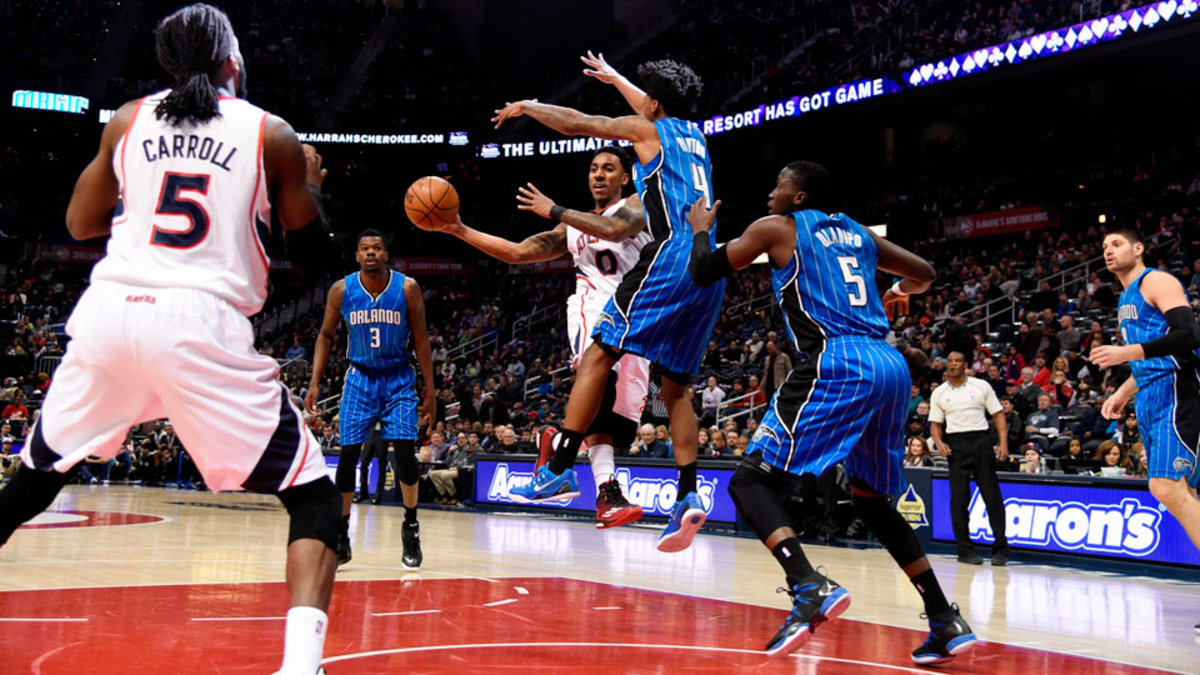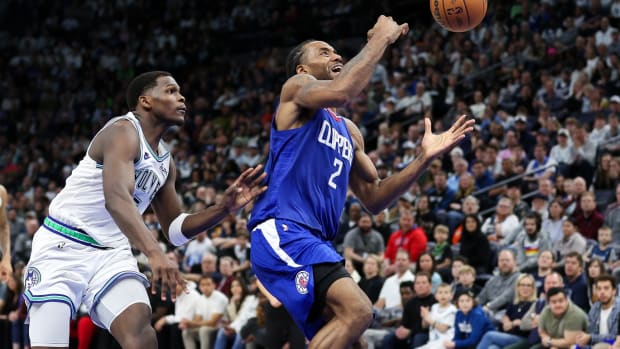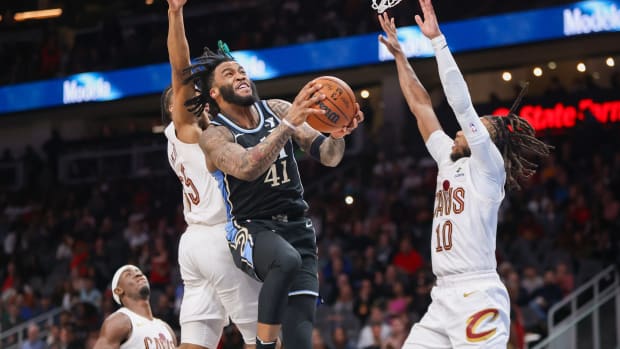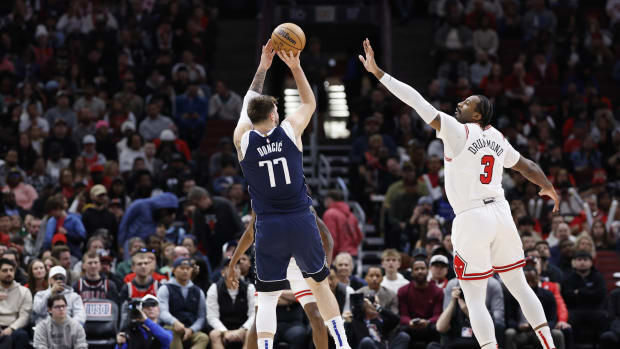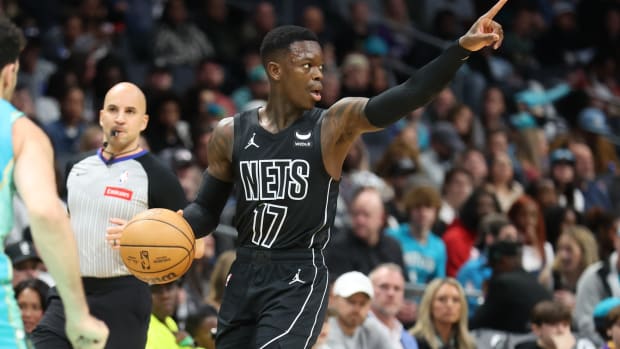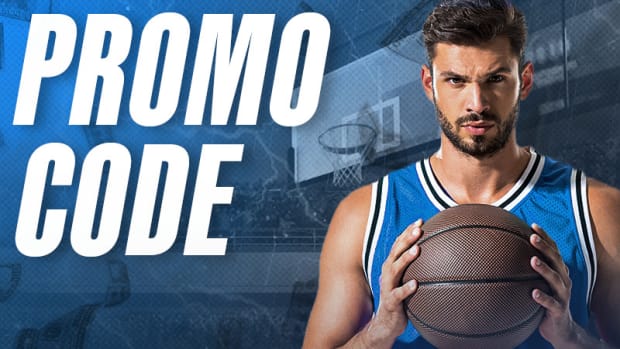Atlanta Hawks: Doing their fair share
This story appears in the Mar. 9, 2015 issue of SI. To subscribe, click here.
When the basketball coaches at Boston University summoned players to Case Gymnasium for individual workouts in the fall of 1982, Rick Pitino always seemed to pick Happy. Pitino was a 30-year-old coach, and Happy was a sophomore point guard who had transferred from Missouri expecting to blow past mid-major competition. If teammates tried screening for Happy, he waved them away, certain he didn’t need the help. “I felt I’d win any one-on-one situation,” he says. “I just wanted to go score.” But a point guard in Pitino’s system had to make everybody else happy as well. “You’re strong and you’re fast,” the coach acknowledged, “but what if they put a bigger defender on you, or trap you, or run a triangle on you?” Pitino demonstrated how a savvy ballhandler can leverage the attention he commands. “He showed me how to use picks, take angles, involve all five guys,” remembers Happy, who dished out 662 assists in three seasons at Boston, then a school record, and guided the Terriers to the NCAA tournament for the first time in 24 years.
Outside of BU, Happy is known as Shawn Teague, point guard patriarch. After two fruitless NBA tryouts, Shawn and his wife, Carol, settled in Indianapolis and raised three boys, to whom he imparted Pitino’s lessons. Jeff, the middle son, played at a YMCA where teams had to pass four times before they shot. He joined an adult league at The SportZone where he had to maneuver around men 20 years older. On his backyard hoop he ran sets in the dark so he could sense spots on the floor without looking at them. At Pike High he memorized where every starter was positioned on every play, and he rejoiced when they all finished with 10 to 12 points. He once grew so excited by a behind-the-back assist to shooting guard Lou Hogan that he broke into a dance at half-court. “Jeff made you feel like you were as good as he was,” Hogan recalls.
But Indianapolis was teeming with talent in the mid-2000s—from Eric Gordon to Mike Conley, Greg Oden to Josh McRoberts—and Jeff couldn’t even get Pitino, let alone other top Division I coaches, to notice him. “I felt like I had to change,” he says, “so people would pay attention.” It was a sad statement about amateur basketball, but an honest one. In the AAU season between his junior and senior years, Jeff consciously morphed into an Iversonian gunner, and recruiters took the bait. He landed a scholarship from Wake Forest on the day he rushed coast-to-coast in four seconds for a game-winning layup against the vaunted Illinois Wolves.
Jeff was suddenly a scoring guard, and after he averaged 18.8 points with a paltry 3.5 assists as a sophomore at Wake, the Hawks drafted him 19th in 2009 and plugged him into a stilted isolation offense. His primary responsibilities involved feeding forward Josh Smith and occasionally throwing up a floater at the end of the shot clock. “That style made me lazy,” Teague says. “I didn’t cut. I didn’t slash. I didn’t move without the ball.” When critics dismiss the NBA as glorified one-on-one, they are likely referencing those Atlanta teams.
Shortly after sharpshooter Kyle Korver joined the Hawks 2½ years ago, he told Teague how he liked to receive passes when racing around pin-down screens. “He’d never been taught stuff like that,” Korver recalls. “It wasn’t his fault. It was how he’d been programmed.” Rather, it was how he’d been re-programmed. When Shawn watched the Hawks, he cringed, wondering where the kid from The SportZone had gone. “He hated how we played,” Teague says of his father. “He wasn’t even a Hawks fan. He was a Spurs fan.” San Antonio’s incessant movement took Shawn back to Pitino, as did the Spurs’ coaching staff, which included former BU teammate Brett Brown, one of Gregg Popovich’s top assistants. Another was Mike Budenholzer. In May ’13, Atlanta hired Budenholzer to replace coach Larry Drew, just as Teague entered restricted free agency. He was a middling 6' 2", 180-pound speed merchant, prepared to sign with the Bucks, where Drew waited with more isos. But Budenholzer had scouted Teague coming out of Wake, had met him through Brown and had heard about Happy. “Jeff knew good basketball,” Budenholzer says. He helped persuade a wary front office to match a four-year, $32 million offer sheet, and the quest to untangle Teague’s DNA began.
Atlanta has accomplished more this season than in any of the past 46. The Hawks have put together the best record in the Eastern Conference. They’ve produced a club-record four All-Stars. They’ve had a 19-game winning streak. They’ve compensated for a lack of size and depth with balanced box scores and sledgehammer screens. They’ve proved that elegant offense exists outside the Alamo, and that Americans can share the ball as selflessly as Europeans. They’ve charmed a jaded city, overcome a mortifying scandal and done it all while the franchise is for sale and the general manager is on leave. In light of everything, maybe it’s insignificant that they’ve also allowed an Indiana point guard to reclaim his basketball soul. But the story of Jeff Teague is the story of the Hawks and the modern NBA, discovering a better way to play, which was evident all along.
Mookie Blaylock's downward spiral and the family he dragged with him
Teague is the unlikely conductor of this hardwood orchestra. After Budenholzer was hired, he called his new point guard and said, “We’re going to do something totally different than what you’re used to.” Teague was reluctant. The Hawks weren’t a great team—since moving from St. Louis in 1968, they’ve reached the conference finals only twice—but they weren’t terrible, either. In Teague’s four seasons before Budenholzer’s arrival, the Hawks averaged 45 victories and won two playoff series. They made him a starter and paid him well. Then he reported to training camp in September 2013 and couldn’t find his chair. “You’re over there now,” said reserve big man Gustavo Ayon, motioning to the spot between center Al Horford and forward Mike Scott. Budenholzer wanted players sitting next to one teammate they could influence and another who could influence them. This is crazy, Teague thought. Budenholzer also wanted the Hawks eating dinner together after road games. “Breaking bread,” he called it. Elton Brand has been in the league 15 years, Teague said to himself. He’ll be out with some business partner.
Teague sits at the kitchen table in his 31st-floorBuckhead apartment, admiring the view. It is a clear, cold afternoon, and the granite colossus that is Stone Mountain rises beyond his floor-to-ceiling windows. But the 26-year-old is drawn to a different natural phenomenon. Teague is watching a clip of the Atlanta offense in a January game at Toronto. In the possession that piques his interest, the Hawks make six passes to five players. The ball switches sides twice yet never hits the ground. Power forward Paul Millsap turns down a five-footer, and Teague turns down an open three so Korver can line up a more open three. “That’s what we do,” Teague says. “That’s who we are. Everybody touches the ball, nobody dances with it, and even if you’ve got a layup, you give it to Kyle Korver.”
Budenholzer installed his version of the read-and-react offense, with hints of Popovich and Mike D’Antoni. “We’ve basically got two plays—strong and weak,” Teague explains. “That gets us into positions, but from there, we all have to make split-second decisions on what we do out of it: maybe a high pick-and-roll, or a dribble handoff, or Kyle coming around a screen. We look at the defense and just do what feels right. Other teams will call out, ‘Thumb four!’ and we know exactly what they’re going to do. No one knows what we’re going to do because we don’t even know ourselves. It’s like controlled pickup.”
They must adhere to a few rules. No one is allowed to hold the ball for more than two seconds, and when somebody drives, others have to account for a few key spots: the low block, the top of the circle and the 45-degree marks on the wings. “We pass to those places blind,” Teague says.
The system demands constant cutting and screening, which can cause claustrophobia. Early last season, whenever Teague tried to clear out and drive on a slower guard, a teammate seemed to flash in front of him. “What are we doing?” he asked. “If I have some space, I can get to the basket!” “Trust me,” Budenholzer shot back. “I’ve seen this work for Tony Parker a million times.” Point guards and their coaches spar often, but from early February to early March, the Hawks dropped 14 of 15 games and Teague lost faith. “I went back to my old habits,” he says. “Give me iso and get out of the way.” In one-on-one film sessions, Budenholzer kept telling Teague, “You’re still not cutting hard enough.”
Kenny Atkinson, a prized Atlanta assistant under both Drew and Budenholzer, saw a player stuck between eras and identities, asking existential questions: Am I a scorer? Am I a passer? Who am I? Atkinson provided the best and straightest answer: “You can be a complete point guard in this system. You can do it all.” Drive and kick, pick-and-roll, pocket passes and corner threes—the domain of the NBA’s most dynamic floor generals, from Chris Paul to Damian Lillard, Kyrie Irving to, yes, Tony Parker. Teague started to recognize, as his father did a generation before, that all the screeners and cutters were not trying to muck up his spacing. They were presenting him with options.
The Hawks lost again in the first round of the playoffs, but they pushed Indiana to seven games, and 6' 9" Paul George was the only Pacer who could corral Teague. Then San Antonio won the championship, and everybody from Golden State to Toronto said they wanted to operate more like the Spurs. Atlanta was already on its way. “I guess you don’t have to score 28 points anymore,” Teague reasoned, “for people to notice.”
One preseason projection pegged Atlanta for 40.5 wins, the same number as the Knicks. The starters could shoot and pass, like San Antonio’s, but they weren’t Hall of Famers and they weren’t European. The Spurs popularized the notion that international players, unspoiled by AAU, are best equipped to thrive in egalitarian systems; the Hawks’ starting five represent America’s heartland: Indiana, Iowa, Michigan, Louisiana and Alabama.
A Giant Shadow: Did Wilt Chamberlain have a son? Levi may be living proof
The predictions looked accurate on Nov. 18, when Atlanta lost to the Lakers and fell to 5–5, prompting an interminable film session at Philips Arena. “We were still fighting it,” Brand says. “We saw that we weren’t doing the little things—the extra pass, the extra effort, the box-out.” Those became the qualities that define the Hawks. When Korver sinks a three off a Brand screen, the first words you hear from the bench are, “Yeah, EB! We see you, EB! Clean ’em up, EB!” Korver gets congratulated later. “Everyone is part of the shot,” Korver says. “Everyone matters, and if you feel like you matter, you take ownership.” No Atlanta starter averages more than 17 points or fewer than 11. All five were named Player of the Month in January. They split the award like they share the ball.
The Hawks compare themselves to an expensive watch (“We’re all a gear,” says guard Kent Bazemore) and a deep-dish pizza (“We’re all a piece,” says Teague). When Teague took a charge this season, he hollered at Brand, “My first one ever!” And when he returned from a gimpy hamstring, he asked Budenholzer if he could come off the bench, “so I don’t mess us up.” A WWE devotee, Teague likens himself to Rey Mysterio, Korver to Shawn Michaels, Horford to Hulk Hogan, Millsap to The Undertaker. The team plays UNO or Spades together on the plane and adheres to breaking bread on the road, despite the limited menu options. “Coach takes us to these fancy Italian restaurants, with foie gras and escargot,” Brand laments. “We’re like, Hey, anybody got any french fries with ketchup over here?”
Contrary to his foodie tendencies—undoubtedly- acquired over 19 years spent alongside Popovich—Budenholzer still rides MARTA to the arena. He went to a Drake concert with small forward DeMarre Carroll. He calls or texts players after tough losses: “Thinking about you, man. Don’t worry about the last shot. We got another one tomorrow.” The Hawks refer to him as Bud, which is appropriate. “I’ve never had a coach care about me like this,” says Teague, who has eaten dinner with Budenholzer’s family and plays one-on-one with his sons before games.
While You Weren't Watching: Stop sleeping on the Atlanta Hawks
The 45-year-old Bud is a near lock for Coach of the Year, but as acting GM, he also warrants consideration for Executive of the Year. Two summers ago he lobbied for Teague and Millsap, recruited Carroll and Korver. They weren’t glittery free agents, but they were quick thinkers, able to handle the freedom he was about to give them. “I wanted to play for the Spurs for 10 years,” Korver says. “They kind of came to me.” Bud Ball is good for everybody, but no one has blossomed as much as Teague, who at week’s end was averaging a career-high 16.7 points and 7.3 assists. “A lot of guys in this league, after three or four years, they’re kind of done: This is who I am. This is what I’m going to be,” Korver says. “Jeff mentally remade himself. Everything we do starts with him—coming off the screen, sucking in two defenders, reading the pick-and-roll, reading the weakside coverage and making the right decision. He dictates it.”
Whether he would have taken the leap elsewhere, with a different coach and a different system, is disorienting to consider. “What we do here is so fun, so free-flowing, it would be hard going back to iso ball again,” Teague says. Even his dad is cheering again. On Feb. 6, the Hawks beat the West-leading Warriors 124–116 in a track meet that featured 59 assists and 60 attempted threes. Afterward, Atlanta coaches unwound in the locker room. “That,” Atkinson gushed, “was a game from the future.”
To hear the Hawks, they have happened upon basketball utopia, a hoop paradise set against a stormy backdrop.
Steve Koonin rushes up the stairs of Philips Arena in a white dress shirt and a pin-striped suit. He wants you to get a clear view of the new projection system that transforms the court into a 3-D movie screen during pregame introductions, and then he wants you to see the rollicking crowd filling the bar at Chops Clubside, and he also wants you to know this is the eighth straight sellout, and TV ratings are up almost 100%, and a new oyster bar may be on the way and, oh, did you notice Martin Luther King III just rolled in?
The Hawks made Koonin their CEO last April, and five months later the franchise imploded. First, controlling owner Bruce Levenson announced he was selling the club, partly because of the revelation that he had sent an email two years earlier urging the organization to target suburban whites, whom he believed were alienated from games by an abundance of African-American fans. Then, GM Danny Ferry took a leave of absence after saying on a conference call that free agent Luol Deng “has a little African in him. Not in a bad way, but he’s like a guy who would have a nice store out front but sell you counterfeit stuff out of the back.” Koonin was left to repair the damage, though in many ways the work had already begun.
Levenson’s email wasn’t just offensive, it was misguided. Koonin had market research indicating the Hawks should actually take the opposite approach from what their owner espoused. “We are aggressively targeting millennials and African-American consumers,” he says. “Those are the people who show the highest predisposition to our product. Why would we chase the people who don’t?” In January the Hawks hosted Swipe Right Night, inspired by the dating app Tinder. In February they screened the movie Selma for fans. The white-haired CEO has emboldened his social media staff—“It’s O.K. America. You still have these Hawks,” social media manager Jaryd Wilson tweeted after the Super Bowl, earning 5,300 retweets—and diversified his marketing force. One consultant is Rev. Toussaint K. Hill Jr. of the West Hunter Street Baptist Church. No word on the reverend’s opinion of Tinder.
Budenholzer and Koonin form an odd couple. One came from the Spurs, understated and tight-lipped. The other came from the entertainment industry and could headline a show himself. Koonin sells the Hawks as few others ever have. His family goes back 100 years in Atlanta, and he was a season-ticket holder for 30. In 1988 he attended the legendary Atlantic Records 40th-anniversary concert at Madison Square Garden but left early because the Hawks were hosting a playoff game against the Celtics the next day. He lowers his voice reverentially when he evokes Dominique Wilkins.
Before Koonin rose up the ranks at Turner Entertainment Networks, he steered marketing at Coca-Cola, signing Kobe Bryant out of high school for $30,000. Koonin understood the significance of stars, finding them and promoting them. But these Hawks have shifted his perspective. “I get emails from parents who tell me, ‘I drove an hour and a half to the game because I want my daughter to see what a team looks like,’ ” Koonin says. “They appreciate that there’s not one guy.”
Larry Bird makes a great joke about Dominique Wilkins statue
Barring collapse, the Hawks will capture the No. 1 seed in the East, but Koonin is an Atlantan, so he knows better than to daydream about championships. “Can you spray champagne if you win the Southeast Division?” he asks, like a true Braves fan. Several Hawks are on bargain contracts, including Millsap and Carroll, who will be unrestricted free agents this summer. According to Koonin, the plan is to maintain the core, but the club is still for sale and Ferry remains in limbo. A different regime could have other ideas. “These guys have proved,” Koonin says, “that a new owner would be foolhardy to mess with the magic they’ve built.”
When the Clippers found themselves in a similar crisis last spring, after the racist rant by then owner Donald Sterling, the team was rattled. Like the Clippers, the Hawks held meetings and aired concerns, but after that they took refuge in basketball. They didn’t need an owner or a GM. The back picks and hockey assists provided order amid chaos. The game was so pure compared with the politics surrounding it.
Even during last month’s All-Star break, when the Hawks invaded New York, they seemed to miss down-home hoops. One night after they returned to Atlanta, Budenholzer flew to Duke for the North Carolina game, and the next, Teague drove to Georgia State in downtown Atlanta because R.J. Hunter was playing.
Hunter is a 6' 6" junior shooting guard who starred at Pike High alongside Teague’s younger brother, Marquis, currently with the Oklahoma City Blue of the D-League. Marquis was a first-round pick, and Hunter probably will be as well. His smooth three-point stroke recalls Korver’s at Creighton. Sitting in the fifth row behind the Panthers’ bench, wearing a black ski cap, Teague blends into the modest gym. He tracks Hunter, who is feverishly trying to wriggle free, setting a screen, making a cut, racing around another screen, making another cut. He never stops moving. When he finally gets the ball and drills the three, he’s earned it. The band erupts. “He’s an Indiana kid,” Teague says. “He knows how to play.”






























